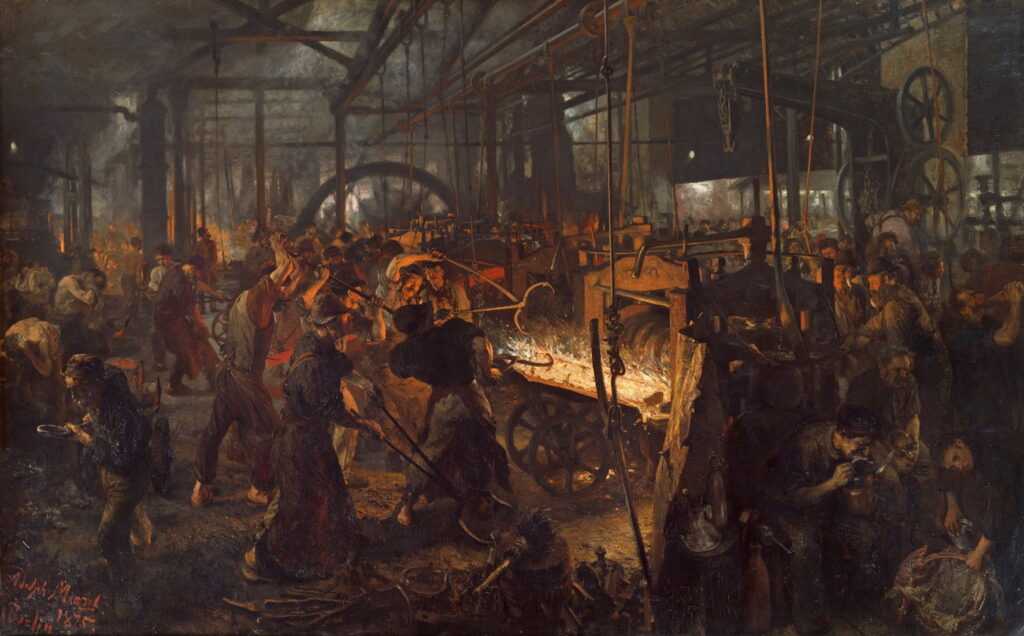Urban Revolutionaries: 3 Factories

If country folk were to be drawn into towns and cities, those urban areas had to provide paid work. During the early decades of the industrial revolution those jobs were often in mills and factories near the source of their raw materials or power. Towns grew rapidly across the coalfields of northern Europe as mines were sunk to extract the coal, and again where iron ore was readily available. As canals and railways enabled supplies to be moved further and faster, towns and cities flourished as centres of manufacturing.
William Armstrong (1822–1914), Toronto Rolling Mills (1864), further details not known. Wikimedia Commons.
By the middle of the nineteenth century, large scale iron production had already started in North America. In 1857, investors opened a site for the production of iron primarily for the growing railways across Canada, and a few years later William Armstrong painted those Toronto Rolling Mills (1864). By this time, it was the largest iron mill in Canada, and the largest manufacturing industry in the city, but it was soon surpassed by steel mills and shut down in 1873.
John Ferguson Weir (1841-1926), The Gun Foundry (1866), oil on canvas, 118.1 x 157.5 cm, Putnam County Historical Society, Cold Spring, NY. Wikimedia Commons.
John Ferguson Weir took his dark realism before an unusual motif for American painting at that time, the hot, harsh, and dangerous world of the West Point Iron and Cannon Factory, in The Gun Foundry (1866). The moment shown here is the casting of a Parrott Gun, in the foundry responsible for making most of the large guns used by the Union forces during the Civil War. This was located to the north of New York City, where there was a rich supply of timber, local iron ore, and water power.
John Ferguson Weir (1841-1926), Forging the Shaft (1874-7 after original of 1868), oil on canvas, 132.1 x 186.1 cm, The Metropolitan Museum of Art (Purchase, Lyman G. Bloomingdale Gift, 1901), New York, NY. Courtesy of The Metropolitan Museum of Art.
Weir’s Forging the Shaft is a replica painted in 1874-7, after the original of 1868 was destroyed by fire. It shows the same foundry, this time working the massive propellor shaft for an ocean liner, more a symbol of peace and trade than past conflict.
Adolph von Menzel (1815–1905), The Iron Rolling Mill (1875), oil on canvas, 158 x 254 cm, Alte Nationalgalerie, Berlin, Germany. Wikimedia Commons.
Adolph von Menzel’s The Iron Rolling Mill from 1875 gives a good impression of the crowded, sweaty, and dangerous environment in which iron and steel workers spent, and sometimes lost, their lives.
Constantin Meunier (1831–1905), Steel Foundry (date not known), media and dimensions not known, Koninklijk Museum voor Schone Kunsten, Antwerp, Belgium. Image by Ophelia2, via Wikimedia Commons.
Production of steel on an industrial scale started after 1857, with the introduction of the Bessemer Process. Constantin Meunier’s undated Steel Foundry must therefore have been painted during the 1860s or later.
The dangers of iron and steel work are obvious today, and claimed many casualties at the time. Few employers had any concern for the safety of those who worked in these conditions, as there was a steady supply of young and able men to keep production rolling and profits accruing.
Charles Frederic Ulrich (1858–1908), The Village Printing Shop, Haarlem (1884), oil on panel, 54 × 58.3 cm, Terra Museum of American Art, Chicago, IL. Wikimedia Commons.
Not all industries were heavy, hot or sweaty. Charles Frederic Ulrich painted a young apprentice drinking during a moment’s pause in his work in The Village Printing Shop, Haarlem (1884).
Christian Ludwig Bokelmann (1844–1894), Lead Mine in Selbeck (1888), oil on cardboard, 50 × 60 cm, Alte Nationalgalerie, Berlin, Germany. Wikimedia Commons.
Christian Ludwig Bokelmann’s oil sketch of a Lead Mine in Selbeck (1888) has a more subtle social message for an ancient industry that had long recognised the toxicity of the lead it worked with, but continued to employ children.
Jean-Eugène Buland (1852–1926), Un Patron, or The Apprentice’s Lesson (1888), oil on canvas, 102 x 82 cm, Nationalmuseum, Stockholm, Sweden. Image by Erik Cornelius, via Wikimedia Commons.
The Naturalist artist Jean-Eugène Buland tackled more complex issues in his Un Patron, or The Apprentice’s Lesson (1888). After France’s ignominious defeat in the Franco-Prussian War, efforts were made to make France more industrial and more modern. Here a young boy is being trained by the foreman to make a cogwheel, when many would have preferred him still to be at school.
Alessandro Milesi (1856–1945), The Spinners (date not known), oil on canvas, 50 x 62.5 cm, location not known. Wikimedia Commons.
Painting men and women at work was by no means confined to Naturalists, with their attention to fine detail. Alessandro Milesi’s undated The Spinners is a much looser oil sketch that could qualify as being an Impression. This shows one of the lighter industries that employed predominantly women.
Maximilien Luce (1858–1941), Charleroi Foundry, Casting (1896), oil on canvas, 130 x 162 cm, Musée de l’hôtel-Dieu, Mantes-la-Jolie (Yvelines), France. By Pierre Poschadel, via Wikimedia Commons.
Maximilien Luce painted many works showing people at work, as his style moved on from Neo-Impressionism to Post-Impressionism during the 1890s. His Charleroi Foundry, Casting (1896) shows this well, and is one of a long series he painted showing those working in heavy industry in this city in the mining area of Belgium.
Hans Baluschek (1870–1935), Steel Rolling Mill (1910), oil on canvas, 63.5 × 91 cm, location not known. Wikimedia Commons.
With the decline of Naturalism in the early twentieth century, the emphasis on workers weakened, and artists like Hans Baluschek returned to painting heavy plant and processes in his Steel Rolling Mill (1910).
Robert Sterl (1867–1932), Ironworkers (Krupp) (1919), oil on cardboard, 23.5 × 31 cm, location not known. Wikimedia Commons.
Finally, Robert Sterl’s Ironworkers of 1919 is an oil sketch showing workers at one of the Krupp plants in Germany. Their only protective clothing is a heavy leather apron.
For those used to agricultural work, factories were relentlessly demanding. Workloads didn’t change with season, and each year passed without the celebration of harvest home. Few employers had easier work available that might offer those recovering from illness or injury a little respite, and as age took its toll on their bodies the only alternative was unemployment.


